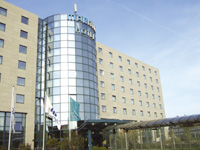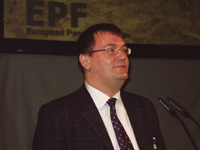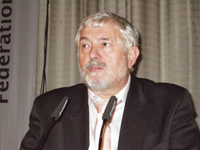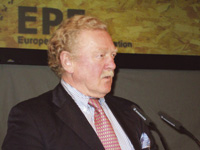Holding together
10 December 2008Opening the symposium at the Maritim Hotel, Hannover airport, Kris Wijnendaele, secretary general of both the European Panel Federation (EPF) and European Federation of the Plywood Industry (FEIC), pointing out that federations can offer little except
communication, appealed to a sector of the audience: “Technical people, your challenge is to develop new products and solutions with your customers to create [more] demand”.
Returning to his theme of communication, Mr Wijnendaele highlighted the booklet produced by EPF and CEI-Bois entitled Tackle climate change: use wood.
“Use this book to spread the message through your own channels,exhorted the secretary general.
President of the EPF, Ladislaus Döry, then summarised the current situation, gave some of the industry-specific statistics from the federation’s annual report (WBPI issue 5, 2008, p16) and outlined the recent activities of the EPF.
“We are in the same, wooden, boat and it is incredibly important that we hold together. Each one of us has a role to play in influencing the European Commission, Parliament or Council in reaching the right decisions.
“There are too many companies who think it is enough to be a member of a federation and do nothing more. We must make people aware of decisions being taken on our behalf by these organisations, which influence our industry – if we don’t we will lose,he warned.
Expressing the need for cross-sectoral cooperation, Mr Döry said: “The larger the voice and the greater the repetition, the bigger the chance that the message is heard. The EPF wishes to expand its
traditional activity network to partners outside the traditional woodworking chain and invites its associate members
to enhance the cooperation and to
strengthen the industry voice.
“We aim to build a global coalition to: Strive for the recognition of harvested wood products under the Kyoto Protocol during the COP-15 convention in November 2009 in Copenhagen; and exchange information and experience that is useful for improving the image and enhancing the consumption of wood products all over the world.
“The EPF is setting up a partnership with associations in Australia, Japan, Korea, Malaysia and North America,said the president.
Mr Döry added that the European Commission has stated, this year, in the Commission Communication on the competitiveness of the EU forest based industries that:
“Forests and forest based industries have a strategic role in climate change mitigation that should be strengthened.
“Carbon storage in harvested wood products can extend the carbon sequestration benefits provided by forests; their role in mitigating climate change should thus be developed”.
The next speaker was Jeremy Wall of the European Commission’s Textiles, fashion and forest based industries unit, who spoke on The impact of EU policies on the competitiveness and future of the wood based panel sector.
Mr Wall said that the policy situation is very complex with regard to national and European policies affecting the forest based sector policy, with no overall policy as yet. Hence the communication document COM (2008) 113 Final on Innovative and sustainable forest based industries in which the speaker is involved.
He pointed out that 7.5% of the total added value of EU manufacturing industries is accounted for by the forest based and related industries, with 9% of the employment of EU manufacturing industries (three million people) and more than 340,000 companies. These figures include pulp and paper and printing.
Mr Wall confirmed the perceived challenges for the EU forest based industries as: Access to raw materials; impact of climate change policies; innovation, research and development; trade and cooperation with third countries; and communication and information.
This appeared to be reassuringly
similar to the EPF’s own assessment of the situation.
Among the eight actions for the EC outlined by the speaker were: Member states, industry and forest owners to facilitate and promote afforestation, reforestation and active sustainable forest management; to explore additional solutions, besides mobilisation, to the gap between supply and demand for wood; to increase the recovery level of wood products; to pay attention to the different uses of biomass when developing the national biomass action plans and in the context of general monitoring and reporting on resource efficiency.
Additionally, Mr Wall said member states and industry are to consider the Strategic Research Agenda of the Forest-based Sector Technology Platform in their RTD programmes and make adequate provision for education and training in the forest based sector. This was one among many proposals to assist the forest products sector.
The speaker said there is a need for the panels sector to lobby nationally and at EU level. “Lobbying is not just writing letters then hoping, it is active formulation and presentation of alternative policy scenarios into the policy making process,said Mr Wall.
Professor Udo Mantau of the University of Hamburg looked at wood availability in Europe with specific reference to panels in a project with the UNECE/FAO Timber Section.
His work predicted that wood consumption for energy use, if EU targets are realised, will rise from 349 million m3 in 2005 to 768 million m3 in 2020.
Professor Mantau said that the consequences are that: Overall energy and resource efficiency are crucial, while the significance of the gap in demand and supply lies in the need for increased wood supply (from existing or new sources, or through imports); policy targets will not be met (with wood); and the development of the wood based industries is in question.
The next speaker was Volker Thole of the University of Applied Sciences in Eberswalde, who looked at Agricultural residues for particleboard and fibreboard production: Potentials and properties.
He said that around 248 million tonnes per annum (tpa) of such residues are ‘available’ to the panel industry, although with a total loss factor of 0.80.
However, Dr Thole said that the need of the wood based panel industry in Europe for lignocellulose-containing raw material was 34 million tpa and the existing amount of agricultural plants was 54.5 million tpa – more than enough.
Annual plants have a higher ash content, shorter basic fibres though longer technical fibres (bast fibres), a lower bonding strength, more parenchyma, a lower crop cost and a higher storage cost than wood.
Dr Thole concluded that the utilisation potential of annual plants is high, but the main problem is their availability, high ash content and the resin usage. However, boards with sufficient mechanical properties can be produced.
Marie-Lise Roux of the French furniture institute FCBA reported on the mechanical performance of furniture constructed of particleboards made from agricultural residues. She advised the audience that low density boards gave some problems in breakage and screw/fastening holding and that strength would be improved if they were laminated with high pressure laminate (HPL).
GreCon of Alfeld Germany, in the form of managing director Kai Greten, gave a presentation on Safety engineering in the wood based panels industry and outlined his company’s various products and processes for fire detection/extinguishing.
The next speaker was Trajan Sandweg of Siempelkamp, Germany who described the company’s fifth generation of prodiQ software for monitoring and controlling the whole production process of composite panels on the line and coordinating all the process data inputs received.
Hauke Kleinschmidt of Electronic Wood Systems, Hameln, Germany, explained his company’s on-the-line quality control systems and concentrated on the Gauge Controller and the latest development of the Conti-Scale non-contact board scale.
The famous Sunds name has been revived by Dieffenbacher following its takeover of part of the former Metso Panelboard business and Kenth Eklund and Fritz Schneider jointly presented Sunds MDF Technologies’ Evojet dry resin blending system.
Helmut Roll of Pallmann, Germany, described the principle of refining and his company’s radial discharge system for the fibre exiting the refiner.
The last of the supplier/sponsor presentations in this session was by Marko Pertillä of Raute, Finland, who explained how his company can maximise quality veneer yield in plywood production.
Opto-electronic evaluation of veneer cutting tests and strategies to optimise veneer yield was the lengthy title of Jochen Aderhold’s presentation. He reported on work by the Wilhelm-Klauditz-Institute, Braunschweig, Germany (WKI and co-organiser of the symposium) to best utilise large diameter logs for high-quality veneer. Using surface data recording, image processing and cutting simulation the researchers were able to confirm trends from cutting trials and visual post-grading and evaluate yield potential, said
Dr Aderhold.
Joris van Acker of the University of Ghent, Belgium reported that moisture dynamics might be a very good tool to help in predicting the service life of plywood, especially when focusing on use class 3 (exterior); and may have applications for OSB as well.
Georg Börste of Andritz, Austria, was the final presenter on day one and he explained how the company’s Durametal LemaxX logarithmic spiral technology in refiner grinding plate design can save energy for the panel maker, as well as increasing plate life.
Kicking off day two, Mario Beyer of the Institut für Holztechnologie (ihd), Dresden, reported that when coating MDF with liquid or powder, electrical conductivity improved the coating of edges, and evenness of coating with powder, and that increased raw density and homogeneous raw density profile improved the finish. He also found that low equilibrium moisture content would avoid bubbles during powder coating.
The next speaker, uniquely, came from a panel maker – Luigi Frati of Italy. Giulio Merlino explained the advantages and flexibility of design obtained by digital printing of Frati’s NEXTfloor digitally printed flooring.
The next presentation, by Michael Ketzer of Johns Manville Sales was unusual in that it described the use of StabilStrand glass non-woven material for surfacing all kinds of engineered wood products, including panels, to improve a variety of panel properties.
Chris Phanopoulos of Huntsman Polyurethanes looked at how MDI bonds to wood and how it can be modified to reduce thickness swell, while at the same time reducing resin loading.
Peter Meinlschmidt of the WKI reported on the success of his work on developing a non-destructive testing method for checking bond quality using ultrasound-excited thermography. He was able to detect many cracks, bonding problems and structural weaknesses on the production line. Future work involves making his ultrasound system contact-less.
The resin production process needs careful monitoring to optimise the system and Dimitris Papapetros of Chimar Hellas, Greece, described the use of NIR Spectroscopy and Chimar’s patented GNOSSI software in monitoring the entire process in real time.
In a departure from pure wood or other fibre based panels, Wim Grymonprez from Deceuninck NV of Belgium talked about wood plastic composites (WPC). He defined these as: “A material or product made by the combination of one or several cellulosic materials with one or several thermoplastics and being, or to be, processed through polymer processing techniques”. Uses include decking and cladding panels.
A CEN Technical Specification became official in mid-2007 and an EN standard for WPCs is expected in 2011.
Durability of wood products is a big issue, especially if its use is to be extended to exterior applications. One way to add durability is by acetylation of the wood. Michael Maes of Titan Wood in the Netherlands reported that Titan’s trademark Accoya wood first went into commercial production in March 2007 making solid wood products.
Acetylation effectively transforms free hydroxyl groups into acetyl groups, reducing water absorption and making the wood indigestible to organisms which would attack it. It also gives dimensional stability and durability.
Test have been carried out on MDF made from acetylated wood, giving potential applications in facades, fascia and soffit and use in wet interior applications such as swimming pool furniture/signage.
Professor Rainer Marutzky of WKI and co-organiser of the symposium reviewed, compared and contrasted global formaldehyde regulations and requirements.
“If you want to export to anywhere in North America [next year] you will have to meet the CARB [California Air Resources Board] regulations,he warned.
Jean-Marie Gaillard of FCBA then reported on an FEIC plywood formaldehyde testing project. He said the determination on correlations was due by the end of 2008.
Staying with formaldehyde, Professor Edmone Roffael of the University of Göttingen, Germany, gave an overview of formaldehyde scavengers in wood based panels, added to the resin prior to pressing or to the boards after pressing. He also said that some wood extractives have scavenging potential.
The final speaker for this year’s symposium was Kristina Durkic of resin maker Dynea. Her subject was Performance efficient technology for low emission panels. She presented Dynea’s AsWood resin, which she said performs better than E1 grade melamine urea formaldehyde resin.
This was a well-attended conference, especially given the economic circumstances (although many may have booked before the real economic bad news hit) and attendees included 76 people representing panel manufacturing concerns (with multiple representation from some).
Reactions of delegates I spoke to concerning the quality of the content were mixed, but of course it is true that you can’t please everybody.
For further information or copies of the proceedings, please contact the EPF at info@europanels.org



